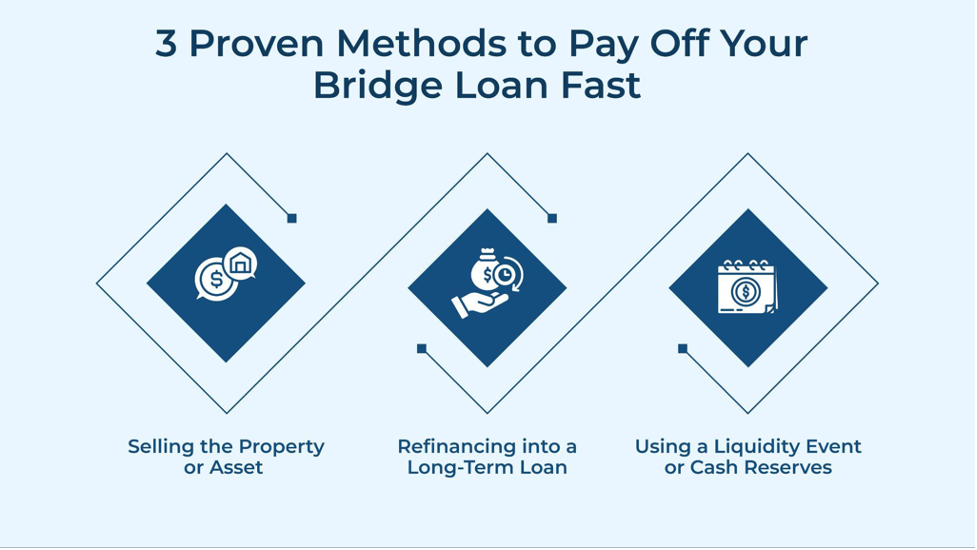
Bridge loans offer fast, flexible financing for time-sensitive opportunities, helping borrowers cover gaps between transactions—whether purchasing a new property before selling an existing one or funding a renovation project. However, their short repayment terms, typically 12 months, mean that without a solid plan, what starts as a financial solution can quickly become a source of stress. High interest rates and fees accumulate rapidly if the loan isn’t repaid on time, leading to unnecessary financial strain.
That’s why having a clear exit plan is essential. Whether you plan to repay through asset sales, refinancing, or improved cash flow, the right approach can make all the difference.
In this blog, we’ll discuss the smart ways to repay your bridge loan quickly, helping you minimize costs and protect your financial health.
3 Proven Methods to Pay Off Your Bridge Loan Fast

Paying off a bridge loan quickly can help reduce interest costs and improve your financial flexibility. The right repayment strategy depends on your financial situation and plans. Here are three proven methods to accelerate bridge loan repayment.
1. Selling the Property or Asset
Many borrowers use bridge loans to finance a property purchase while waiting to sell an existing asset. Selling the property is one of the most straightforward ways to pay off a bridge loan. Once the property is sold, the proceeds can be used to clear the outstanding balance, including principal and accrued interest.
This method is prevalent for:
- Homeowners who buy a new home before selling their old one.
- Real estate investors who flip properties for a profit.
- Businesses selling off commercial property or equipment.
Pros:
- Provides a clear, direct path to repaying the loan in full.
- Eliminates the need for long-term financing.
- Reduces interest costs by paying off the loan sooner.
Cons:
- Requires the property to sell within the loan term, which may not always be predictable.
- If the market is slow, you may need to lower the price, affecting your expected profits.
- Delays in selling could lead to extension fees or default risk.
Tip: To avoid delays, list the property early, work with experienced real estate professionals, and consider competitive pricing strategies.
2. Refinancing into a Long-Term Loan
If selling the property isn’t feasible within the bridge loan term, refinancing into a long-term loan can be a practical alternative. This involves securing a new mortgage or commercial loan with lower interest rates and extended repayment terms, using the new loan to pay off the bridge loan.
Refinancing is ideal for:
- Investors waiting for property values to increase before selling.
- Business owners who need more time to stabilize cash flow.
Pros:
- Low monthly payments compared to a bridge loan.
- Provides financial stability by replacing a short-term loan with long-term financing.
Helps avoid potential penalties or default risk if a sale is delayed.
Cons:
- Requires good credit and financial standing to qualify for favorable loan terms.
- Additional closing costs and fees may apply.
Tip: Start the refinancing process well before your bridge loan matures to avoid last-minute delays or unexpected disqualifications.
3. Using a Liquidity Event or Cash Reserves
Some borrowers plan to pay off their bridge loan through a liquidity event, such as selling a business, receiving an inheritance, or cashing out investments. Others may have substantial savings set aside to clear the debt without relying on another financing option.
This method works well for:
- Business owners expecting a large revenue inflow.
- Investors with maturing assets or stock sales.
- Borrowers who want to avoid long-term debt and interest payments.
Pros:
- Offers immediate repayment, reducing interest costs significantly.
- No need for refinancing, avoiding additional loan fees.
Cons:
- Relies on the timing of the liquidity event, which may not always be certain.
- Draining cash reserves could impact other financial priorities or emergency funds.
Tip: If you plan to use a liquidity event, ensure it aligns with your bridge loan term to avoid penalties or financial stress.
Is Remortgaging a Viable Solution for Bridge Loan Repayment?
Remortgaging to pay off a bridge loan can be a strategic financial move. By transitioning from a short-term bridge loan to a conventional mortgage, borrowers can secure more affordable, long-term financing while reducing financial pressure.
However, evaluate your options carefully, as remortgaging after a bridge loan may impact your mortgage offers.
The Strategic Advantages of Remortgaging After a Bridge Loan
Since bridge loans have short-term repayment periods, borrowers must plan a clear exit strategy to avoid financial strain. The most common repayment options include remortgage, selling the property, or selling a different asset. Among these, remortgaging is often preferred, offering long-term financial stability and structured repayment terms.
Switching to a Secured Mortgage: A regular mortgage can be an exit strategy for repaying a bridge loan. While a bridge loan is short-term, a mortgage consolidates the payment into a more extended repayment period, reducing monthly costs and providing a more financially stable solution.
Lower Interest Rates: Bridge loans tend to have higher interest rates, especially when compared to long-term mortgages. By remortgaging, borrowers can save on interest costs, potentially leading to significant savings over the life of the loan.
Debt Consolidation: Remortgaging can simplify your finances by consolidating other debts, such as credit card or personal loan balances, along with your bridge loan. This can lead to lower overall interest rates and fees, helping to streamline your payments.
Better Equity: If the property has undergone renovations or improvements funded by the bridge loan, its value may have increased. Remortgaging can help release this newly built equity, providing access to additional funds for further investments or property improvements.
Alternative Strategies to Repay a Bridge Loan
Borrowers can consider alternative strategies for repaying a bridge loan besides remortgage. These methods utilize the property’s value through rental income or by tapping into built-up equity.
Using Equity Release for Bridge Loan Repayment
Another strategy for repaying a bridge loan is using equity, particularly if the property’s value has increased since the bridge loan was taken out. This is one of the bridge loan refinancing alternatives that allow you to borrow against the increased value of the property, providing the necessary funds to repay the bridge loan.
This approach is commonly used by homeowners and investors who have built equity in their property, either through appreciation in market value or by making improvements to the property. Once you’ve secured the new loan based on the equity, you can use those funds to pay off the bridge loan.
Can You Repay a Bridge Loan Early?
Yes, you can repay a bridge loan early, and in many cases, it’s encouraged. Repaying the loan before the end of the term can offer several advantages, especially for borrowers who can secure the funds ahead of schedule. You must clear out the bridge loan repayment terms and conditions beforehand. The cost of repaying a bridge loan early is less than when paying on time.
Here are a few main points to consider when repaying a bridge loan early:
Interest Savings: Repaying your loan early can reduce your overall interest. Since interest on bridge loans is often calculated daily, paying off the loan as soon as possible will prevent interest from accumulating further.
Improved Credit Rating: Early repayment can positively impact your credit score by showing you can manage debt responsibly. This can be beneficial for future borrowing opportunities.
No Penalties (In Some Cases): Some bridge loan lenders offer flexibility for early repayment without imposing penalties. However, not all lenders follow the same policy, so checking your agreement for early repayment charges (ERCs) is essential. These charges are calculated based on the loan amount and the period for which the loan was held.
Enhanced Cash Flow: By repaying your bridge loan early, you can free up cash that would have been used for interest payments. This is especially useful if you have other financial obligations or investment opportunities to focus on.
Building Trust with Your Lender: Repaying a loan early can help you build a positive relationship with your lender, which may benefit you if you need financing in the future.
Partner with Bluestone for Flexible Loan Solutions and Seamless Repayment
When paying back a bridge loan, having the right financing options can make all the difference. Bluestone Commercial Loans offers flexible solutions to support your real estate goals:
- Bridge Loans: Ideal for securing time-sensitive deals and quickly accessing capital while waiting for permanent financing or property sale.
- Fix-and-flip loans Help real estate investors swiftly purchase, renovate, and resell properties by covering acquisition and renovation costs.
Why Partner with Bluestone?
Efficiency & Adaptability: We recognize the importance of time in your business and provide swift, flexible financing solutions with competitive rates and streamlined paperwork.
Proven Track Record: Our portfolio showcases a diverse array of high-quality business loans secured by commercial real estate. Bluestone has consistently delivered successful financing solutions, from smaller loans to multi-million-dollar investments.
Tailored Support: You will have direct access to Bluestone’s experienced team, which is dedicated to understanding your goals and offering customized financial solutions to help you achieve them swiftly.

